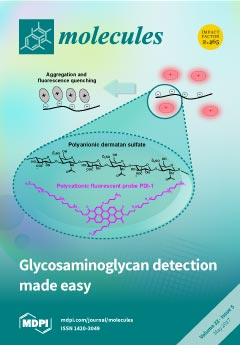1
Laboratory of Pharmaceutical Chemistry, Faculty of Pharmacy and Food Sciences, and Institute of Biomedicine (IBUB), University of Barcelona, Av. Joan XXIII; 27-31, E-08028 Barcelona, Spain
2
Department of Clinical Pharmacology, Flinders University and Flinders Medical Centre, Bedford Park, SA 5042, Australia
3
Institut de Chimie des Substances Naturelles, CNRS UPR 2301, Université de Paris-Saclay, 91198 Gif-sur-Yvette, France
4
Department of Drug Sciences, Medicinal Chemistry and Pharmaceutical Technology Section, Centre for Health Technologies (CHT), University of Pavia, Viale Taramelli 12, 27100 Pavia, Italy
5
Organic Chemistry Laboratory, University of Mons-UMons, 7000 Mons, Belgium
6
School of Pharmacy, Faculty of Health Sciences, University of Eastern Finland, P.O.Box 1627, FI-70211 Kuopio, Finland
7
Medicinal Chemistry Research Group, Research Centre for Natural Sciences, The Hungarian Academy of Sciences, Magyar tudósok körútja 2, H-1117 Budapest, Hungary
8
Department of Pharmacology and Toxicology, College of Pharmacy, The University of Arizona, Tucson, AZ 85721, USA
9
Department of Chemistry, Institute of Infectious Disease and Molecular Medicine, and South African Medical Research Council Drug Discovery and Development Research Unit, University of Cape Town, Rondebosch 7701, South Africa
10
Department of Nutrition, Food Science, and Gastronomy and Institute of Biomedicine, University of Barcelona, Av. Prat de la Riba 171, 08921 Santa Coloma de Gramenet, Spain
11
Pharmaceutical & Medicinal Chemistry Department, Faculty of Pharmacy, Al-Quds University, POB 20002 Jerusalem, Palestine
12
Department of Sciences, University of Basilicata, Viadell’Ateneo Lucano 10, 85100 Potenza, Italy
13
Pharmaceutical Institute, University of Bonn, An der Immenburg 4, 53115 Bonn, Germany
14
Key Laboratory of Receptor Research, Shanghai Institute of Materia Medica, Chinese Academy of Sciences, 555 Zu Chong Zhi Road, Shanghai 201203, China
15
Rome Center for Molecular Design, Department of Drug Chemistry and Technology, Sapienza University, P.le Aldo Moro 5, 00185 Rome, Italy
add
Show full affiliation list
remove
Hide full affiliation list






